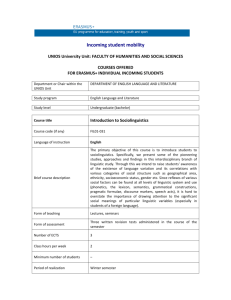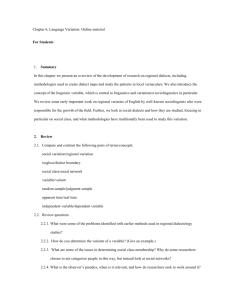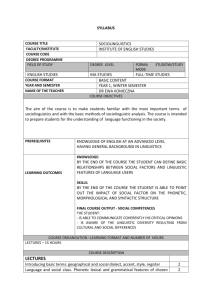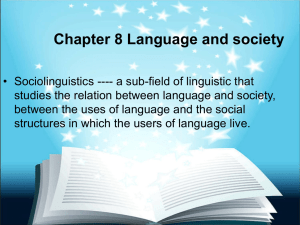خلاصه-
advertisement
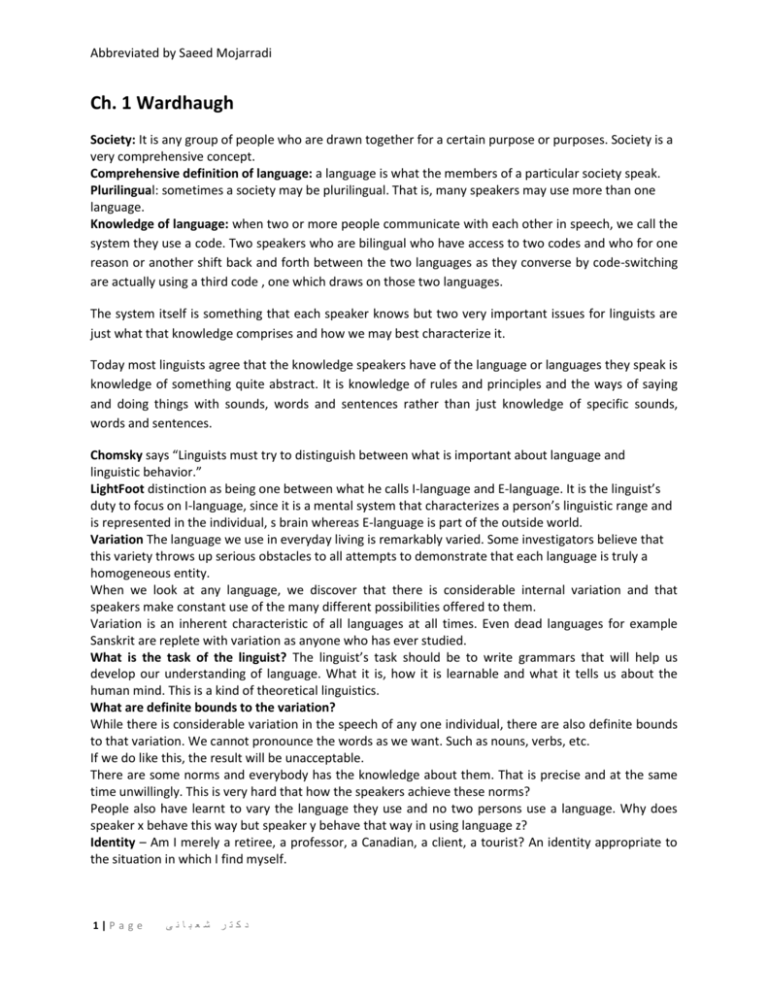
Abbreviated by Saeed Mojarradi Ch. 1 Wardhaugh Society: It is any group of people who are drawn together for a certain purpose or purposes. Society is a very comprehensive concept. Comprehensive definition of language: a language is what the members of a particular society speak. Plurilingual: sometimes a society may be plurilingual. That is, many speakers may use more than one language. Knowledge of language: when two or more people communicate with each other in speech, we call the system they use a code. Two speakers who are bilingual who have access to two codes and who for one reason or another shift back and forth between the two languages as they converse by code-switching are actually using a third code , one which draws on those two languages. The system itself is something that each speaker knows but two very important issues for linguists are just what that knowledge comprises and how we may best characterize it. Today most linguists agree that the knowledge speakers have of the language or languages they speak is knowledge of something quite abstract. It is knowledge of rules and principles and the ways of saying and doing things with sounds, words and sentences rather than just knowledge of specific sounds, words and sentences. Chomsky says “Linguists must try to distinguish between what is important about language and linguistic behavior.” LightFoot distinction as being one between what he calls I-language and E-language. It is the linguist’s duty to focus on I-language, since it is a mental system that characterizes a person’s linguistic range and is represented in the individual, s brain whereas E-language is part of the outside world. Variation The language we use in everyday living is remarkably varied. Some investigators believe that this variety throws up serious obstacles to all attempts to demonstrate that each language is truly a homogeneous entity. When we look at any language, we discover that there is considerable internal variation and that speakers make constant use of the many different possibilities offered to them. Variation is an inherent characteristic of all languages at all times. Even dead languages for example Sanskrit are replete with variation as anyone who has ever studied. What is the task of the linguist? The linguist’s task should be to write grammars that will help us develop our understanding of language. What it is, how it is learnable and what it tells us about the human mind. This is a kind of theoretical linguistics. What are definite bounds to the variation? While there is considerable variation in the speech of any one individual, there are also definite bounds to that variation. We cannot pronounce the words as we want. Such as nouns, verbs, etc. If we do like this, the result will be unacceptable. There are some norms and everybody has the knowledge about them. That is precise and at the same time unwillingly. This is very hard that how the speakers achieve these norms? People also have learnt to vary the language they use and no two persons use a language. Why does speaker x behave this way but speaker y behave that way in using language z? Identity – Am I merely a retiree, a professor, a Canadian, a client, a tourist? An identity appropriate to the situation in which I find myself. 1|P a g e دکتر شعبانی Abbreviated by Saeed Mojarradi One identity is neither some essential quality one has born with or acquired nor a stereotype that one appears to fit. Identity is something that is formed and shaped through action. (Richard) and demonstrated through performance and action. Identity is constructed from interaction with others and is the result of our socialization. Race, ethnicity, gender, religion, occupation, physical location, social class, kinship, leisure activities, etc. Identity is created in dealing with such factors and in dealing with members of groups … Identity – 1-individual identity 2-group identity Much of what we find in linguistic behavior will be explicable in terms of people seeking to perform, negotiate, realize or even reject identities through the use of language. In fact the language is expressing strongly the identity by cultural things such as cloth, option, food and so on. The groups possess identity, too. Concepts such as community, social network and community of practice. The groups can be long –lasting or temporary, large or small, close-knit or casual. In all of the above we must recognize that power has a significant role to play. Power is the ability to control events in order to achieve one’s aims. Language and society – sociologists attempt to understand how societies are structured and how people manage to live together. To do so , they use such concepts as identity , power , class , status , solidarity , accommodation , face , gender , politeness , etc. There are several possible relationships between language and society. A second relationship is directly opposed to the first: linguistic structure and or behavior may either influences or determine social structure. A third possible relationship is that the influence is bi-directional. Language and society may influence each other. A fourth possible relationship is to assume that there is no relationship at all between linguistic structure and social structure and that each is independent of the other. Holms say that the sociolinguistics aim is to move towards a theory which provides a motivation. Sociolinguistics and the sociology of Language Sociolinguistics is concerned with investigating the relationship between language and society with the goal being a better understanding of the structure of language and of how languages function in communication. The equivalent goal in the sociology of language is trying to discover how social structure can be better understood through the study of language. E.g how certain linguistic features serve to characterize particular social arrangements? The difference: Hudson has described the difference as follows: sociolinguistics is the study of language in relation to society. Whereas the sociology of language is the study of society in relation to language. In other words in sociolinguistics we study language and society in order to find out as much as we can about what kind of thing language is , and in the sociology of language we reverse the direction of our interest. Coulmas says that micro-sociolinguistics investigates how social structure influences the way people talk and how language varieties and patterns of use correlate with social attributes such as class, sex and age. Macro-sociolinguistics, on the other hand, studies what societies do with their language, that is , attitudes and attachments that account for the functional distribution of speech forms in society, language shift , maintenance and replacement , the delimitation and interaction of speech communities. Labove: deals with large –scale social factors, and their mutal interaction with languages and dialects. 2|P a g e دکتر شعبانی Abbreviated by Saeed Mojarradi There are many open questions, and many practical problems associated with the decay and assimilation of minority languages, the development of stable bilingualism, the standardization of language and the planning of language development in newly emerging nations. According to Trudgill, certain kinds of work combine insights from sociology and linguistics. Examples of such work are attempts to deal with the structure of discourse and conversation, speech acts, studies in the ethnography of speaking, investigating of such matters as kinship systems. For Trudgill there is still another category of studies in which investigators show a concern for both linguistic and social matters. Studies of this type are based on empirical work on languages it is spoken in its social context and are intended to answer questions and deal with topics of central interest to linguists. Interventionist approach – this work has been called linguistics with a conscience and a cause one which seeks to reveal how language is used and abused in the exercise of power and the suppression of human rights by a critic. (Widdowson) this approach derives from critical theory which is concerned with the processes by which systems of social inequality are created and sustained. Tollefson who champion an approach called critical discourse analysis. This work focuses on how language is used to exercise and preserve power and privilege in society, how it buttresses social institutions , and how even those who suffer as a consequence fail to realize how many things that appear to be natural and normal. Methodological Concerns – Sociolinguistics should encompass everything from considering who speaks or writes what language or what language variety to whom and when and to what end. (Fishman) it must be oriented to both data and theory that is any conclusions we come to must be solidly based on evidence. Those who seek to investigate the possible relationship between language and society must have a twofold concern. They must ask good questions, and they must find the right kinds of data that bear on those questions. Hudson ch.1 p: 1-8 Sociolinguistics: We can define sociolinguistics as the study of language in relation to society. Sociolinguistics has become a recognized part of most courses at university level on linguistics or language and is indeed one of the main growth points in the study of language, from the point of view of both teaching and research. Like other subjects, sociolinguistics is partly empirical and partly theoretical, partly a matter of going out and amassing bodies of fact and partly of sitting back and thinking. The armchair approach to sociolinguistics can be fairly productive, whether it is based on facts collected in a systematic way as part of research or simply on one’s own experience. Of course personal experience is a rich source of information on language in relation to society. However, it will soon become clear that the armchair approach is dangerous for two reasons if it is applied to personal experience alone. First, we may be seriously wrong in the way in which we interpret our own experience, since most of us are not aware of the vast range of variation in speech we hear and react to in our everyday lives. Secondly, personal experience is a very limited base from which to generalize about language in society. The differences between sociolinguistics and linguistics? Linguistics differs from sociolinguistics in taking account only of the structure of language, to the exclusion of the social contexts in which it is learned and used. 3|P a g e دکتر شعبانی Abbreviated by Saeed Mojarradi Sociolinguistics and the sociology of language: The study of society in relation to language defines what is generally called sociology of language. Sociolinguistic phenomena An imaginary word What is there to say about language in relation to society? It may be helpful to start by trying to imagine a society about which there is a very little to say. The little world described below is completely imaginary and sociolinguists would agree that it is highly unlikely that any such world either does or even could exist , given what we know about both language and society. Ch.2 Languages, Dialects, and Varieties Wardhaugh 23- 41 What do we mean by variety? Hudson defines a variety of language as a set of linguistic items with similar distribution, a definition that allows us to say that all of the following are varieties: Canadian English, London English, and the English of football commentaries, and so on. According to Hudson, this definition also allows us to treat all the languages of some multilingual speaker or community as a single variety, since all the linguistic items concerned have a similar social distribution. Ferguson offers another definition of variety, anybody of human speech patterns which is sufficiently homogeneous to be analyzed available techniques of synchronic description and which has a sufficiently large repertory of elements and their arrangements or processes. Language or Dialect? While people usually can give a name to a vernacular they speak, they may not always claim to be fully qualified speakers of a bona fide language. They may experience difficulty in deciding whether what they speak should be called a language proper or merely a dialect of some language. Haugen has pointed out that language and dialect are ambiguous terms. Ordinary people use these terms quite freely in speech, for them a dialect is almost certainly no more than a local non-prestigious variety of a real language. Language is used to refer either to a single linguistic norm or to a group of related norms, and dialect is used to refer to one of the norms. The situation is further confused by the distinction the French make between undialect and un patois. The former is a regional variety of a language that has an associated literary tradition, whereas the latter is a regional variety that lacks such a literary tradition. Gumperz has suggested some of the confusions that result from popular uses of the term language and dialect. To these we can add the situation in Scandinavia as further evidence. Standardization – First of all we must know that there are seven criteria that may be useful in discussing different kinds of languages. According to Bell, these criteria (standardization, vitality, historicity, autonomy, reduction, and mixture and defacto norms.) may be used to distinguish certain languages from others. Standardization refers to the process by which a language has been codified in some way, that process usually involves the development of such things as grammars, spelling books, and dictionaries and possibly a literature. Standard English-Trudgill defines Standard English as follows: it is a variety of English which is usually used in print and which is normally taught in schools and to non-native speakers learning the language. It is also the variety which is normally spoken by educated people and used in news broadcasts and other similar situations. 4|P a g e دکتر شعبانی Abbreviated by Saeed Mojarradi The difference between standard and nonstandard, it should be noted has nothing in principle to do with differences between formal and colloquial language or with concepts such as bad language. Standard English has colloquial as well as formal variants and Standard English speakers swear as much as others. Standardization process occasionally results in some languages actually achieving more than one standardized variety. Standardization is also on going matter for only dead languages like Latin and classical Greek is standardized for all time. Standardization process is also obviously one that attempts either to reduce or to eliminate diversity and variety. Vitality – the second of Bell’s seven criteria, refers to the existence of a living community of speakers. This criterion can be used to distinguish languages that are alive from those that are dead. We should note that a language can remain a considerable force even after it is dead, that is, even after it is no longer spoken as anyone’s first language and exists almost exclusively in one or more written forms, knowledge of which is acquired only through formal education. Historicity refers to the fact that a particular group of people finds a sense of identity through using a particular language, it belongs to them, social, political, religious or ethnic ties may also be important for the group. Autonomy – is an interesting concept because it is really one of feeling. A language must be felt by its speakers to be different from other languages. Reduction – refers to the fact that a particular variety may be regarded as a sub-variety rather than as an independent entity. Mixture – refers to feelings speakers have about the purity of the variety they speak. E.g. more important to the speakers of French and German than to speakers of English. Finally de facto norms refer to the feeling that many speakers have that there are both good speakers and poor speakers and that the good speakers represent the norms of proper usage. Final words: a dialect is a subordinate variety of a language, so that we can say that Texass English and Swiss German are respectively dialects of English and German. Hudson 38-42 Language variation and dialectology, Regional and social dialects Regional dialects and isoglosses: We can now turn to an even more fundamental question: how clear are the boundaries between varieties? The hierarchical model of the family tree implies that the boundaries between varieties are clear at all levels of the tree. If the family tree model is right, to identify what are called regional dialects within any larger variety such as English. There is a vast amount of evidence bearing on this question, produced by discipline called dialectology. , particularly by its branch called dialect geography. Example, Bloomfield, Chambers and Trudgill, since the nineteenth century, dialectologists in Europe and the United States have been studying the geographical distribution of linguistic items, such as pairs of synonymous words. The dialect geographer may then draw a line between the area where one item was found and areas where others were found, showing a boundary for each area called an isogloss. The family tree model allows a very important prediction to be made regarding isoglosses, namely that they should not intersect. Distinctions can add further subdivisions within a variety, but they cannot subdivide two varieties at the same time for the simple reason that a tree diagram can show sub 5|P a g e دکتر شعبانی Abbreviated by Saeed Mojarradi classification, but not cross –classification. You cannot use a tree, for example, to divide English both on a north-south axis and also on an east-west axis. According to the family tree model, then, isoglosses should never intersect, because if they did they would be dividing the same population in two contradictory ways. Unfortunately this production is wrong; in fact, it could hardly be further from reality, because cross – classification is the normal, most common relationship among isoglosses. Diffusion and the wave theory – an alternative to the family tree model was developed as early as the nineteenth century to account for the kind of phenomenon we have just been considering. It is called wave theory. It is based on the assumption that changes in language spread outwards from centers of influence to the surrounding areas in much the same way that a wave spreads from the place where a stone is dropped into a pool. Social dialects – dialect differences are not, of course, only geographical, as has been implied in the discussion so far. There are two main sources of extra complexity. Firstly, there is geographical mobility – people move from one place to another, taking their dialects with them even if they modify them in the course of time to fit their new surroundings. The second source of complexity is the fact that geography is only one of the relevant factors, others being class, sex, and age. Therefore, speak of social dialects or socialects to refer to non-regional differences. Social variables affecting speech – Wardhaugh, Ch. 6 p 148-155 Once we have identified the linguistic variable as our basic working tool in an effort to see how linguistic variation relates to social variation. Gumperz studied one cast in a modern mold shows some of the intricacies involved in trying to relate linguistic variations to social variations. Gumperz shows how rather small differences in speech can effectively distinguish sub-groups in society from one another in a society of linguistic usage in the village of khalalpour , eighty miles north of Delhi in India. The social structure of village is determined by Hindu caste membership with Brahmans at the top, then Rajputs (warriors), merchants and several groups of artisans and laborers’ lower down. There are three untouchable classes: 1- Landless laborers 2- Leather worker and shoe makers 3- Bhangis sweepers The latters are restricted to living in certain neighborhoods and have less freedom to move in the village than do members of the upper castes. Muslims are out of the caste system. So far as language is concerned, certain characteristics of Khalapur village dialects are clear markers of social – group membership. E.g. Bhangis do not make certain phonological contrasts that speakers of all the other caste make. If we consider social class to be a useful concept to apply in stratifying society few indeed would deny its relevance. The social system of England in the 1950s was different from what it is today and presumably it will be different again in another half century. Sociologists use a number of different scales for classifying people when they attempt to place individuals somewhere within a social system. 6|P a g e دکتر شعبانی Abbreviated by Saeed Mojarradi An occupational scale may divide people into a number of categories: 1- Major professionals of large businesses 2- Lesser professionals and executives of medium , sized , business , semi professionals 3- Technicians and owners of small businesses, skilled workers, semi-skilled workers and unskilled workers. An educational scale may employ the following categories: Graduate or professional education College or university degree Attendance at college or university but no degree High school graduation and less than seven years of formal education. Income level as well as source of income is important factors in any classification system that focuses on how much money people have, likewise, in considering where people live, investigators must concern themselves with both the type and cost of housing and its location. Wolfram and Fasold point out that there are other objective approaches not exclusively dependent on socio-economic ranking. People are assigned to social classes through the use of composite scores derived from various scales which measure some of the factors mentioned above. Labove in his study of linguistic variation in New York City used tree criteria: Education Occupation Income Mmc / lmc / uwc / mwc / lwc Trudgill interviewed ten speakers from each of five electoral wards in Norwich plus ten schools – age children from schools. These sixty informants were then classified on six point scale (0-5) Occupation, education, income, type of housing, locality and father’s occupation. 7|P a g e دکتر شعبانی

